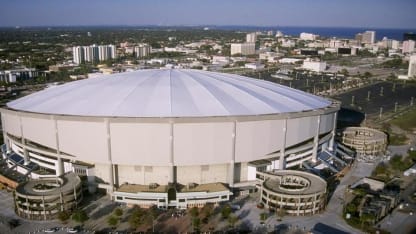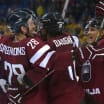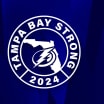"It was a great place to play," Bradley recalled. "We had a lot of success there. The arena was huge and, we drew great crowds there. It was exciting."
After spending the inaugural season inside Expo Hall at the Florida State Fairgrounds, the Lightning determined the arena was too small for hockey and moved across the bay to The Florida Suncoast Dome, which opened in 1990 in hopes of attracting a Major League Baseball franchise but didn't have a full-time tenant, save for the Arena Football League's Tampa Bay Storm.
The brand-new giant structure with the eye-catching slanted white roof became home to the Lightning for the next three seasons while construction on a downtown Tampa arena progressed.
It was renamed the Thunderdome, for obvious reasons.
In one season, the Lightning went from the smallest rink in the NHL to its largest.
"The atmosphere there was kind of fun because we had so many people that came to the games," said Bradley, who scored 24 goals and recorded 64 points in 78 games during his first season in the Thunderdome in 1993-94. "They had fan land and kind of a carnival atmosphere in the background with the tent and stuff like that where kids used to go play and families could go do things besides just watching the hockey game. It was a great place to play. The crowds were always fun and exciting for us to be at the games."
In the playoffs, the atmosphere inside the Thunderdome ratcheted up to another level. Playing in front of a record crowd in Game 3, Alex Selivanov sent the fans into delirium after netting the overtime game-winning goal in a 5-4 Lightning victory that gave Tampa Bay a two-games-to-one advantage over the heavily-favored Flyers.
Bradley counts the memory of that game as his favorite from his three seasons playing at the Thunderdome.
"That's something I'll never forget," he said.
The good feelings didn't last long.
Two nights later, in front of an even bigger Thunderdome crowd of 28,183, a record that still stands today as the largest postseason crowd in NHL history, the Flyers defeated the Lightning 4-1. Philadelphia won the next two games as well to defeat the Lightning in six games and advance. The Flyers were bounced in the next round by the Stanley Cup finalist Florida Panthers.
It would take the Lightning seven more seasons before they'd get back to the postseason in 2003. Meanwhile, the Bolts moved to a brand new arena downtown called the Ice Palace (now AMALIE Arena) in time for the 1996-97 season, and the Thunderdome became the home to the expansion Major League Baseball Tampa Bay Rays in 1998, the name of the building changed again to Tropicana Field, where they have played ever since.
Harkening back to those infancy stages of the franchise's history, the Lightning will don Tampa Bay Rays-themed warmup jerseys featuring a Thunderdome patch, paying homage to the second of three arenas the Bolts have called home, during warmups of tonight's game against the Arizona Coyotes. The unique jerseys will be auctioned off following the game, the proceeds benefitting the Lightning Foundation as well as the Tampa Baseball Museum at Al Lopez House.
Through renovations and upgrades, AMALIE Arena has developed into one of the best rinks in the NHL, giving the Lightning a decided home ice advantage anytime they play there.
But the Thunderdome will always hold a special place in the memories of those who played for the Lightning from 1993 to 1996.
"It was awesome," Bradley said.



















